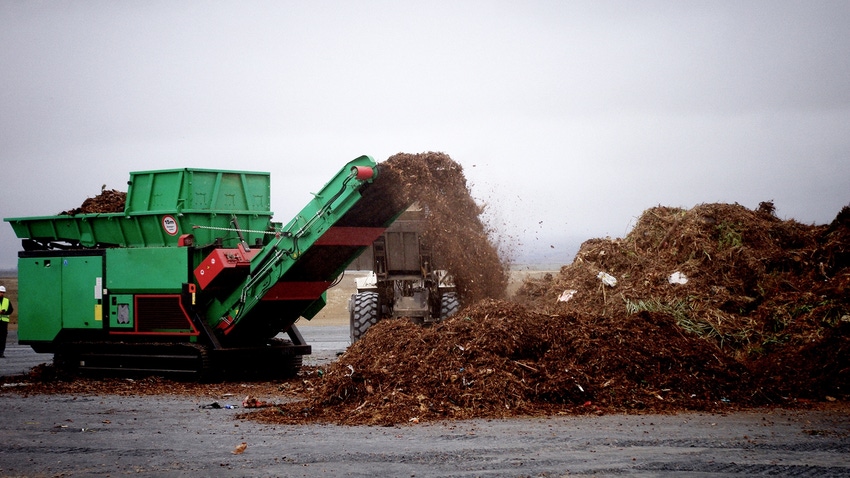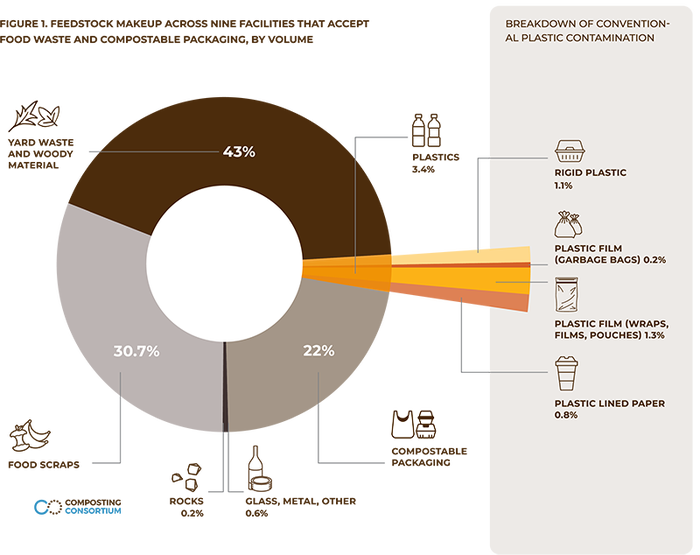The US Composting Industry Has a Plastics Problem
Though it may not be what you think, according to a report from the Composting Consortium, which partnered with 10 compost manufacturers to research contamination rates.

At a Glance
- The study explored the role of conventional plastics and compostable plastic packaging in compost contamination.
- The researchers evaluated contamination in feedstock as well as in finished compost
- Five commonly held beliefs about compost contamination are put to the test by the study’s findings
Despite diligent efforts to combat contamination at industrial composting sites, conventional plastic can persist in the finished compost.
That’s according to the Composting Consortium, New York, which released findings from pioneering research into compost contamination in a report titled “Don’t Spoil the Soil: The Challenge of Contamination at Composting Sites.” The consortium is an industry collaboration led by the Center for the Circular Economy at Closed Loop Partners.
The research captures data from in-field research at 10 leading composting operations of various sizes located across the US, and the report quantifies the contamination in compost feedstock and finished compost. It also discusses decontamination methods and the high cost of managing contamination.
According to the report, curbside collection of organic materials (aka organics) in the US has grown 49% since 2021, but most facilities still process only yard waste. Currently, about 145 full-scale US commercial composting facilities accept food waste and some types of compostable packaging.
“One of the biggest barriers to greater acceptance of food waste and compostable packaging by composters is their concern about increased contamination,” writes Kate Daly, managing director, Center for the Circular Economy at Closed Loop Partners, in the report’s introduction.
But there has been a lack of information regarding contamination rates at US composting facilities, contaminating materials, and how much composters spend to address contamination.
With this research, the “Composting Consortium … aimed to capture a geographically and operationally diverse dataset on contamination volumes and decontamination practices. Our findings from the field put five commonly held beliefs to the test, challenging what many industry stakeholders had previously assumed as fact,” Daly writes.

COMPOSTING CONSORTIUM
Flexible packaging is problematic.
Plastic and packaging are the basis of several of the common beliefs:
Belief #1. “Conventional plastic is the most common contaminant received by composters.” The study’s findings suggest this is true. On average, 85% of feedstock contamination, by volume, is conventional plastic.
Belief #2. “Allowing compostable packaging in the organics streams leads to higher contamination rates.” This is not necessarily true. Most composters in the study had contamination, whether they accepted compostable packaging or not. Several factors contribute to feedstock contamination levels.
Belief #3. “Contamination is a nuisance, but it does not negatively impact a compost manufacturer’s bottom line.” This is untrue. Contamination significantly impacts profitability, with composters earmarking 21% of operating costs, on average, for contamination removal.
Belief #4. “Conventional plastic impacts the quality of composters’ finished product, threatening their businesses and our environment.” The study’s findings suggest this is true. Four out of 10 of the participating composters had trace amounts of conventional flexible plastic in the compost they produced.
Belief #5. “Compostable packaging does not break down and ends up in finished compost.” This is sometimes true; however, the study showed that eight out of nine composters who accept compostable products in their feedstock had no detectable level of compostable packaging in finished compost.
Compost study methodology and plastic contaminants.
The study methodology was modeled “on the 2021 Minneapolis Organics Sort, which sorted materials into categories classified as organics, plastic-lined paper, recyclables and ‘other contaminants,’” according to the report.
The Composting Consortium adapted that approach, breaking out several subcategories of recyclables, including rigid plastic, flexible plastic, and multi-material packaging. In addition, the in-field team measured materials and contaminants by both volume and mass.
Measured by mass, the average contamination rate was 1.2% across all 10 composting facilities. Among the nine that accept compostable packaging in feedstock, the average contamination rate was 1%. Rigid plastic was the most common contaminant.
By volume, the feedstock in the nine facilities that accept both food waste and compostable packaging included 3.4% conventional plastics and 22% compostable packaging.
Of the 3.4% plastics, the breakout was: 1.1% rigid plastic; 0.2% plastic film from garbage bags; 1.3% plastic film from wraps, films, and pouches; and 0.8% plastic-lined paper.
Although the report notes that the consortium’s analysis of contamination is a “snapshot in time, it holds significance for the industry as it can inform and guide on-site operational decisions to effectively mitigate contamination at scale.”
About the Author(s)
You May Also Like




